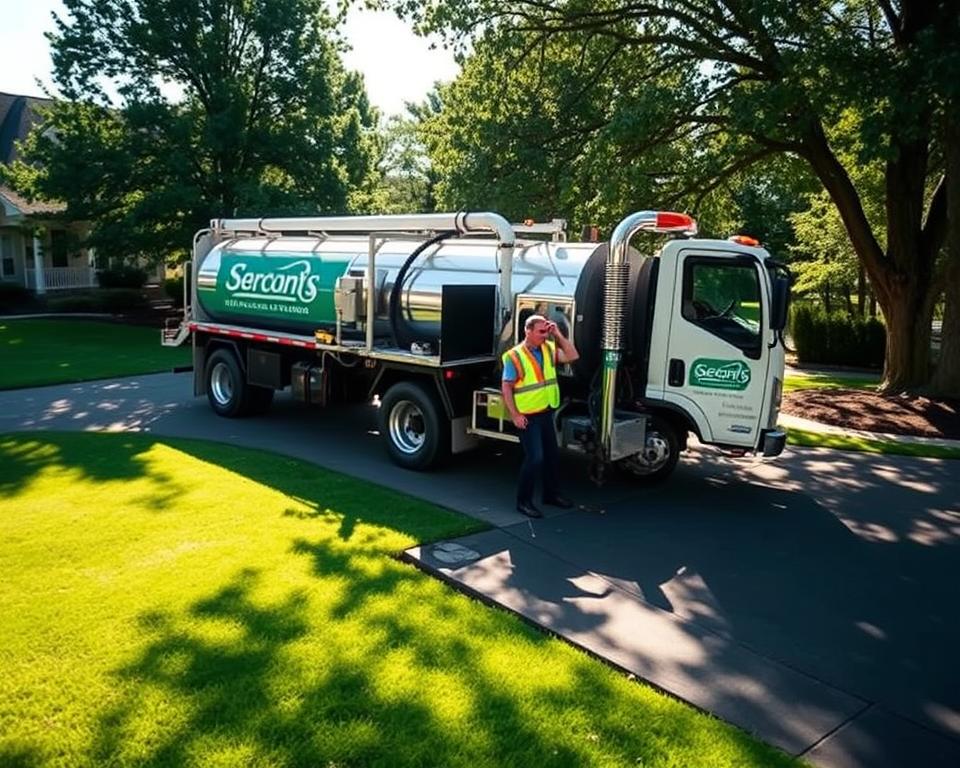Expected Charges for Septic Tank Pumping
Have you paused to consider about the real price of keeping your septic system in good order, or if you’re spending too much? It’s essential for property owners to comprehend the specifics of septic tank pumping prices. On average, the fee sits near $420, yet it can vary widely. This spread comes from elements like your system’s volume and where you live – septic tank service near me.
Regular maintenance of your septic tank avoids costly fixes, emphasizing the importance of understanding service costs. Our goal is to dive into septic tank service pricing in depth. This will enable smart budgeting cost‑effectively for your system’s maintenance.
Core Messages
- Average septic tank pumping runs about $420.
- Prices can range between $290 and $560 based on various factors.
- Regular upkeep helps avoid larger repairs down the line.
- Most households require pumping every three to five years.
- Family size and water usage can influence pumping frequency.
Grasping the Value of Septic Tank Pumping
Septic tank pumping is crucial for a well‑functioning wastewater system. It extracts solids that, if ignored, lead to blockages. Consistent pumping doesn’t just prevents bad smells but also sidesteps steep repair costs.
Neglecting septic tank maintenance can threaten our wide use on these systems. Thankfully, affordable services minimize the risk of system failure. Routine upkeep extends your septic system’s life, ensuring trouble‑free operation.
Pricing for septic tank upkeep illustrates the value of preventive care. Maintenance detects problems at an initial stage, heading off serious damage and hefty repair bills. Regular pumping is a wise move for homeowners to secure their investment and enjoy peace of mind.
Typical Prices for Septic Tank Pumping
Septic tank pumping generally ranges between $250 USD and $600 in cost. Usually, homeowners will spend about $400 USD for this necessary service. Cost swings are driven by elements like tank size, where you live, and how often maintenance is performed. Typical tanks, around a thousand gallons, usually cost between $225 and $400.
Homeowners should realize the importance of budgeting funds every three to five years for septic tank pumping. This regular care depends on the tank’s usage and size. It prevents bigger, pricier issues in the long run, showing to be both labor and budget friendly.

Variables Affecting Septic Tank Pumping Prices
A number of factors are important in setting the fee of septic tank pumping. Knowing these details empowers homeowners to plan for these essential services wisely.
The volume counts greatly. Bigger tanks demand more labor and time to empty, which means higher fees. The reachability to your tank also greatly affects the price. Tanks buried deep or in difficult locations necessitate more hours and specialized equipment from technicians, thus raising the labor costs.
Costs can swing widely based on where you live. This is due to shifts in local labor rates and dumping charges. For example, some areas have higher charges for removing waste, influencing the final service cost. Moreover, tanks with significant solid waste accumulation also incur additional fees—anywhere from $100 to $300. Plus, the more frequently a tank needs pumping—due to higher water usage—the higher the ongoing expenses.
Septic Tank Size and Its Influence on Cost
The capacity of your septic tank directly influences the cost of its upkeep. Smaller tanks, such as, those that can hold 750 gallons, typically have lower pumping costs, usually ranging from $175 to $300. On the other hand, bigger tanks, capable of holding up to 1,750 gallons, may incur charges between $400 and $700. The majority of single‑family residences use tanks that hold between one thousand to 1,250 gallons, providing a balance between volume and performance.
Households with compact systems or large households often require more frequent pumping services, which increases the overall expense. It’s vital to schedule regular septic tank inspections in these situations. This makes sure the tank does not overflow or break down, which helps avoid additional damages. By recognizing the relationship between tank size and service fees, homeowners can reach knowledgeable choices regarding their septic systems and their upkeep requirements.
Location‑Based Changes in Septic Tank Pumping Costs
Septic tank pumping costs can differ dramatically based on area. In urban areas, the expenses are frequently higher due to local septic services experiencing increased overhead. For example, Minneapolis, MN residents may spend between $180 USD and $280 USD, while those in Portland, OR could see prices from $440 USD to $750.
The reasons behind these differences are many. They include local living costs, need for septic specialists, and regional regulations. In places where septic services are limited, homeowners might pay more due to the service scarcity. Moreover, tough regulations in some regions can increase the need for higher compliance fees, impacting the cost of services.
Being knowledgeable about these geographic cost variances is essential for homeowners. It enables them to budget their septic maintenance budget more precisely. By understanding local pricing, they can seek quotes from specialists prudently, maintaining their septic system effectively without breaking the bank.
Additional Costs to Consider with Septic Tank Pumping
Homeowners often fail to consider various additional maintenance costs connected with septic tank pumping. The primary cost includes just the basic service, not covering other potential expenses. Understanding these can assist with creating a complete budget.
CCTV inspections, for instance, fall between $250 USD to $500. They offer a minimally disruptive look into the system’s condition. Additionally, filter maintenance, which if overlooked can create system failures, represents another cost.
The spread for repairs can be wide, from $100 USD to $4,000, based on the specific issues. This spread emphasizes the need of factoring in additional maintenance costs for future budgeting.
Allocating Funds for Septic Tank Maintenance
When planning for septic tank maintenance, it’s important to take a comprehensive view. This includes several critical elements. Owing to variable factors, the cost of maintenance can change considerably. Therefore, proper financial planning is indispensable.
To keep your system functions reliably and to avoid surprise bills, keep these timelines and services in mind:
- Regular pumping: This service is usually required every three to five years.
- Inspections: Set aside for around $250 USD to $1,180 for inspections every three years.
- Potential repairs: Maintain a fund for surprise repairs, which can pop up unexpectedly.
Creating a routine maintenance calendar with a trusted septic service is essential. By expecting these expenses, homeowners can evade the large costs tied to neglect. This approach ensures the life span and efficiency of their septic systems.
Common Signs That Your Septic Tank Needs Pumping
Keeping watch to your septic system’s condition is vital. Identify the early signs that suggest your septic tank needs pumping. Doing so can prevent serious damage and lower repair costs.
- Slow drains: Water that drains slowly in sinks, tubs, or toilets could indicate your septic tank is at capacity.
- Unpleasant odors: Bad smells near the septic tank or in your yard are usually clear indicators of a problem.
- Gurgling sounds: Unusual gurgling from your plumbing might suggest air is trapped because of a blockage.
- Wet spots: Standing water or lush grass patches near the drain field signal waste seepage from the tank.
- Dark green grass: Grass that is deeper green and appears robust around the drain field may indicate leakage of nutrients, suggesting an issue.
Routine checks by septic system experts can maintain your tank is in proper order. Using experienced septic technicians for maintenance stops these issues, guaranteeing your system’s longevity.
Gains of Consistent Septic Tank Inspections
Regular inspections are integral to preserving your septic system in excellent order. They pinpoint potential problems before they become major repairs. By bringing in professionals for these checks, every part of your system undergoes a thorough assessment.
The inspection looks at several parts of your system, including waste levels and the drain field’s condition. It verifies that critical parts, like baffles, work as they should. Catching issues sooner prevents hazardous overflows and safeguards the environment, aiding both your home and the wider community.
Having your septic tank checked every three years can save you a lot of money. It prevents bigger issues from arising due to neglect. This not only cuts on repair costs but also secures your peace of mind.
| Inspection Aspect | Importance |
|---|---|
| Waste Level Assessment | Prevents overflow and backups |
| Drain Field Evaluation | Identifies saturation and function |
| Component Functionality Check | Ensures proper system operation |
| Early Problem Detection | Saves on repair costs |
Strategies to Cut Costs on Septic Tank Pumping Prices
Homeowners aiming to cut septic tank pumping costs have multiple strategic options. Arranging group services with neighbors is one efficient method. This involves coordinating with others nearby to book services as a group, potentially securing group discounts. It’s a way to boost community bonds while managing expenses more economically.
Another practical approach is to enroll in maintenance plans with septic service providers. These plans often include reduced rates for routine check‑ups and pumpings, maintaining septic systems functioning properly at a lower cost. Homeowners are advised to ask about these plans when contacting service companies.
Making the septic tank accessible can also shave pumping expenses. Clear accessibility means there’s no requirement for extra labor charges. It’s smart to keep the area around the tank clear of clutter, permitting straightforward servicing.
Embracing certain habits helps in prolonging the time between pumpings as well. Lowering water usage and limiting garbage disposal use are critical practices. These actions can significantly enhance septic system health, lowering the need for regular maintenance. By embracing these habits, homeowners can successfully trim their septic tank pumping costs, preserving their finances and systems.
In Summary
Ensuring regular septic tank pumping is essential for homeowners who want to keep their waste management system healthy and effective. Knowing about the costs involved enables effective budgeting. This way, you can find cost‑effective septic services without compromising your system’s functionality.
Adopting a preventive approach to maintenance is very advantageous. By watching for indicators that indicate the need for pumping, you can dodge costly repairs and lengthen your system’s lifespan. Such actions not only improve your home’s functionality but also deliver you peace of mind.
In conclusion, keeping up with routine inspections and timely septic tank pumping is critical for effective home maintenance. By focusing on proper planning and choosing affordable septic service, you’ll ensure your septic system remains working and effective for many years.


